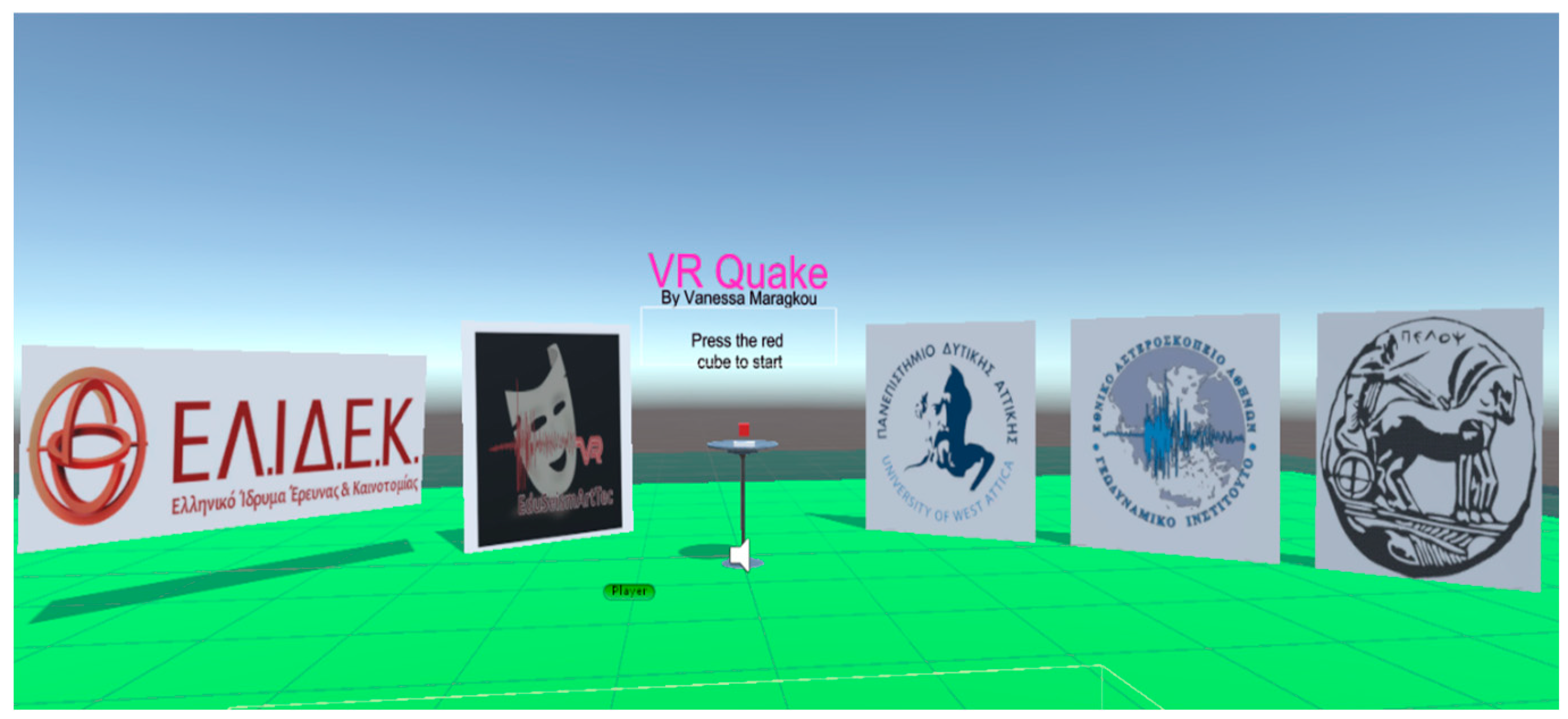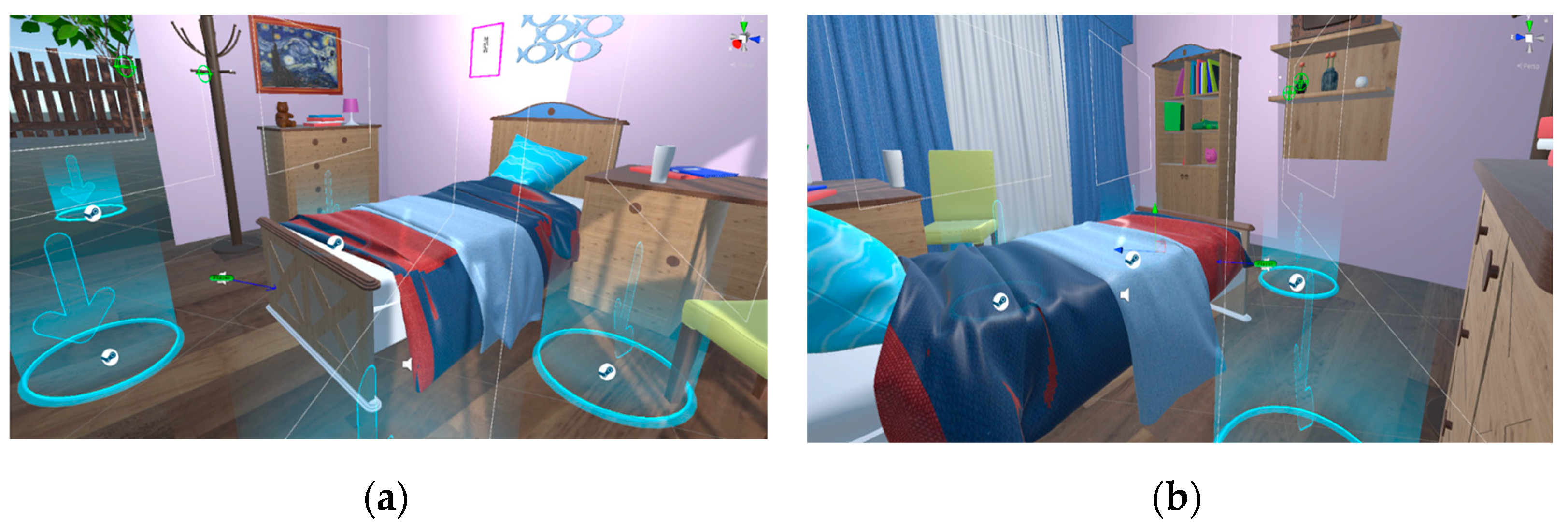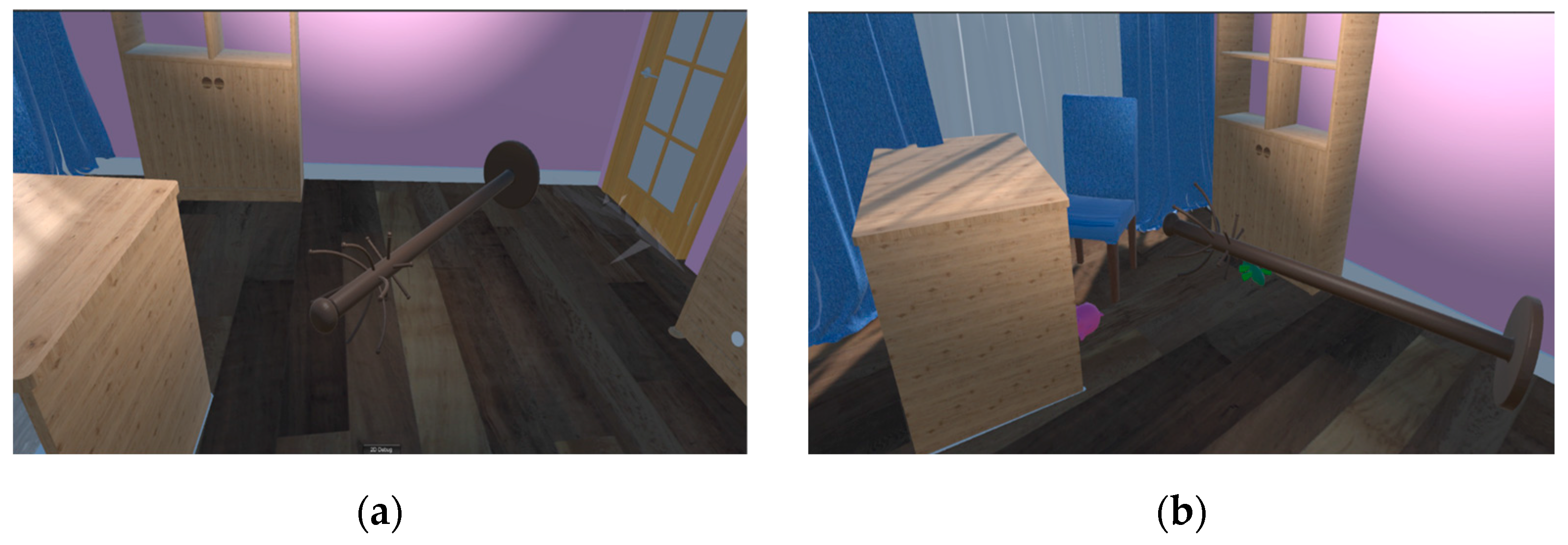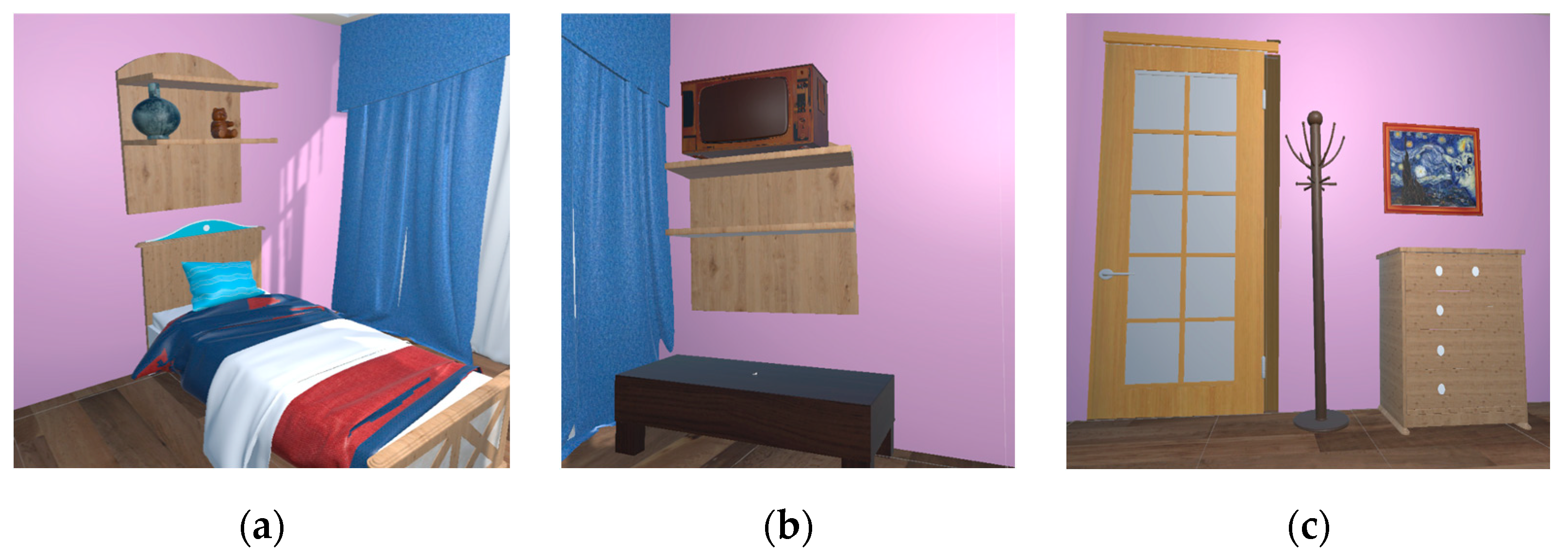Educational Seismology through an Immersive Virtual Reality Game: Design, Development and Pilot Evaluation of User Experience
Abstract
:1. Introduction
- Is VRQuake self-explicatory, understandable and clear?
- Is VRQuake entertaining?
- Do users see a potential for education in VRQuake?
2. Literature Review
3. Materials and Methods
3.1. Design
- Kick-off scene,
- Acquaintance with the room setting and walk about,
- Experience a virtual earthquake while in the room,
- Repositioning room objects or furniture to safer places,
- Selection of items to prepack in a backpack, ready to take away when leaving home in emergency.
3.2. Development
3.2.1. Scene 1: Kick-off Scene
3.2.2. Scene 2: Acquaintance with the Room Setting and Walk about
3.2.3. Scene 3: Experience of a Virtual Earthquake while in the Room
3.2.4. Scene 4: Repositioning of Room Objects/Furniture to Safer Places (Game)
- (a)
- When the user locates an object in a wrong (unsafe) place, he/she should touch it with the virtual hand. A hit (correct object selection) is signaled by a yellow frame showing up around the object, a voice cheering ‘OK!’ and +10 award points in the points frame. Neither of these happens at a miss (wrong object selection).
- (b)
- To move the touched (yellow-framed) object to a safer place, the user ‘locks’ it to the virtual hand by pressing and holding the trigger on the back of the controller. An object thus locked may be freely moved around in the virtual room. The user selects the new, safer place and repositions the object by releasing the trigger on the controller. A hit (correct new place, as in Figure 5) is signaled by an ‘OK!’ voice message and +10 award points in the points frame. Neither happens at a miss (wrong new place); in that case, the user may lock the object and try another place.
3.2.5. Scene 5: Packing an Emergency Backpack (Game)
4. Results
4.1. Quantitative Analysis
4.2. Qualitative Analysis
4.2.1. “For Scene 3 (Virtual Earthquake) to Become More Immersive, I Would Suggest…”
4.2.2. “For Scene 4 (Object/Furniture Repositioning to Safer Places) to Become more Entertaining and/or Educative, I Would Suggest…”
4.2.3. “For Scene 5 (Emergency Backpack Preparation) to Become more Entertaining and/or Educative, I Would Suggest…”
5. Discussion
- (a)
- Along the line of experience: the need for more realistic virtual worlds that would increase immersion and the sense of presence. This need for increased fidelity of the virtual world to the physical one as well as for increased interactivity is reported in existing analogous studies such as [17,19]. Furthermore, the connection between immersion, the sense of presence and VR-facilitated learning is not superficial. Existing research has indicated that immersion, among other factors, is a strong predictor for presence, while presence is a key factor for immersive VR-facilitated learning [33]. (Tele-)presence is conversely indicated as a predictor for immersion elsewhere, [22]. It is clear that these two concepts are closely related. Finally, as concluded in [15], the increased level of immersion offered by HMD-facilitated VR makes it easier to mentally engage the participants.
- (b)
- Along the line of education: the need for more elaborate, comprehensive educational scenarios that provide feedback to the users not only in the form of game scores but also in the form of having the user face the consequences of his/her choices. This is an interesting finding of the qualitative analysis performed in the present research that needs more attention.
Limitations
6. Conclusions–Further Research
Author Contributions
Funding
Institutional Review Board Statement
Informed Consent Statement
Data Availability Statement
Acknowledgments
Conflicts of Interest
References
- Dalgarno, B.; Mark, J.W.L. What are the learning affordances of 3-D virtual environments? Br. J. Educ. Technol. 2009, 41, 10–32. [Google Scholar] [CrossRef]
- Merchant, Z.; Goetz, E.T.; Cifuentes, L.; Keeney-Kennicutt, W.; Davis, T.J. Effectiveness of virtual reality-based instruction on students learning outcomes in K-12 and higher education: A meta-analysis. Comput. Educ. 2014, 70, 29–40. [Google Scholar] [CrossRef]
- Freina, L.; Ott, M. A Literature Review on Immersive Virtual Reality in Education: State of the Art and Perspectives. In Proceedings of the International Scientific Conference E-Learning and Software for Education, Bucharest, Romania, 23–24 April 2015. [Google Scholar]
- Pellas, Ν.; Dengel, A.; Christopoulos, A. A Scoping Review of Immersive Virtual Reality in STEM Education. IEEE Trans. Learn. Technol. 2020, 13, 748–761. [Google Scholar] [CrossRef]
- Izatt, E.; Scholberg, K.; Kopper, R. Neutrino-KAVE: An immersive visualization and fitting tool for neutrino physics education. In Proceedings of the IEEE Virtual Reality, Minneapolis, MN, USA, 29 March–2 April 2014. [Google Scholar]
- Caravaca, G.; Le Mouélic, S.; Mangold, N.; L’Haridon, J.; Le Deit, L.; Massé, M. 3D Digital Outcrop Model reconstruction of the Kimberley outcrop (Gale crater, Mars) and its integration into Virtual Reality for simulated geological analysis. Planet. Space Sci. 2020, 182, 104808. [Google Scholar] [CrossRef]
- Gonzalez–Morin, D.; Gonzalez–Sosa, E.; Perez–Garcia, P.; Villegas, A. Bringing Real Body as Self-Avatar into Mixed Reality: A Gamified Volcano Experience. In Proceedings of the IEEE Conference on Virtual Reality and 3D User Interfaces Abstracts and Workshops (VRW), Christchurch, New Zealand, 12–16 March 2022. [Google Scholar]
- Perez-Ramirez, M.; Arroyo-Figueroa, G.; Ayala, A. The use of a virtual reality training system to improve technical skill in the maintenance of live-line power distribution networks. Interact. Learn. Environ. 2021, 29, 527–544. [Google Scholar] [CrossRef]
- Silva, J.N.A.; Southworth, M.; Raptis, C.; Silva, J. Emerging Applications of Virtual Reality in Cardiovascular Medicine. JACC Basic. Transl. Sci. 2018, 3, 420–430. [Google Scholar] [CrossRef]
- Martingano, A.J.; Persky, S. Virtual reality expands the toolkit for conducting health psychology research. Soc. Personal. Psychol. Compass 2021, 15, e12606. [Google Scholar] [CrossRef]
- Maragkou, V.; Rangoussi, M. French as a foreign language: Design, development and evaluation of an immersive Virtual Reality learning environment. In Proceedings of the International Technology, Education and Development Conference, Valencia, Spain, 5–7 March 2018. [Google Scholar]
- Elliott, J.; Walters, R.; Wright, T. The role of space-based observation in understanding and responding to active tectonics and earthquakes. Nat. Commun. 2016, 7, 13844. [Google Scholar] [CrossRef]
- Balfour, N.J.; Salmon, M.; Sambridge, M. The Australian Seismometers in Schools Network: Education, Outreach, Research, and Monitoring. Seismol. Res. Lett. 2014, 85, 1063–1068. [Google Scholar] [CrossRef]
- Subedi, S.; Hetényi, G.; Denton, P.; Sauron, A. Seismology at School in Nepal: A Program for Educational and Citizen Seismology Through a Low-Cost Seismic Network. Front. Earth Sci. 2020, 8, 73. [Google Scholar] [CrossRef]
- Shu, Y.; Huang, Y.Z.; Chang, S.H.; Chen, M.Y. Do virtual reality head-mounted displays make a difference? A comparison of presence and self-efficacy between head-mounted displays and desktop computer-facilitated virtual environments. Virtual Real. 2019, 23, 437–446. [Google Scholar] [CrossRef]
- Zhang, F.; Xu, Z.; Yang, Y.; Qi, M.; Zhang, H. Virtual reality-based evaluation of indoor earthquake safety actions for occupants. Adv. Eng. Inform. 2021, 49, 101351. [Google Scholar] [CrossRef]
- Feng, Z.; Gonzalez, V.; Trotter, M.; Spearpoint, M.; Thomas, J.; Ellis, D.; Lovreglio, R. How people make decisions during earthquakes and post-earthquake evacuation: Using Verbal Protocol Analysis in Immersive Virtual. Reality. Saf. Sci. 2020, 129, 104837. [Google Scholar] [CrossRef]
- Caballero, A.R.; Niguidula, J.D.; Caballero, J.M. Disaster Risk Management Training Simulation for People with Hearing Impairment: A Design and Implementation of ASL Assisted Model Using Virtual Reality. In Proceedings of the 4th International Conference on Information Technology (InCIT), Bangkok, Thailand, 24–25 October 2019. [Google Scholar]
- Lu, X.; Yang, Z.; Xu, Z.; Xiong, C. Scenario simulation of indoor post-earthquake fire rescue based on building information model and virtual reality. Adv. Eng. Softw. 2020, 143, 102792. [Google Scholar] [CrossRef]
- Rajabi, M.S.; Taghaddos, H.; Zahrai, S.M. Improving Emergency Training for Earthquakes through Immersive Virtual Environments and Anxiety Tests: A Case Study. Buildings 2022, 12, 1850. [Google Scholar] [CrossRef]
- Ooi, S.; Kikuchi, A.; Goto, T.; Sano, M. Development and Verification of Mixed Disaster Training System in Virtual Reality Based on Experience Learning. In Proceedings of the 10th International Conference on Educational and Information Technology (ICEIT), Chengdu, China, 18–20 January 2021. [Google Scholar]
- Mütterlein, J. The Three Pillars of Virtual Reality? Investigating the Roles of Immersion, Presence, and Interactivity. In Proceedings of the 51st Hawaii International Conference on System Sciences, Big Island, HI, USA, 3–6 January 2018. [Google Scholar]
- Tan, C.; Leong, T.; Shen, S.; Dubravs, C.; Si, C. Exploring Gameplay Experiences on the Oculus Rift. In Proceedings of the 2015 Annual Symposium on Computer-Human Interaction in Play, London, UK, 5 October 2015. [Google Scholar]
- Carrozzino, M.; Giuliodori, G.; Tanca, C.; Evangelista, C.; Bergamasco, M. Virtual Reality Training for Post-Earthquake Rescue Operators. IEEE Comput. Graph. Appl. 2023, 43, 61–70. [Google Scholar] [CrossRef] [PubMed]
- Balahadia, F.; Sayaman, J. Development and Evaluation of TYFIREQUAKE: A Virtual Reality Simulation for Disaster Preparedness of Children. Int. J. Comput. Sci. 2023, 7, 1385–1418. [Google Scholar] [CrossRef]
- Doungutha, C.; Theppituck, T. The development of a virtual reality adventure game to prepare for a tsunami disaster. J. Graph. Eng. Des. 2023, 14, 5–14. [Google Scholar] [CrossRef]
- Mol, J.M.; Wouter Botzen, W.J.; Blasch, J.E. After the virtual flood: Risk perceptions and flood preparedness after virtual reality risk communication. Judgm. Decis. Mak. 2022, 17, 189–214. [Google Scholar] [CrossRef]
- Park, S.; Lee, H.; Kwon, M.; Jung, H.; Jung, H. Understanding experiences of older adults in virtual reality environments with a subway fire disaster scenario. Univers. Access Inf. Soc. 2022, 3, 771–783. [Google Scholar] [CrossRef]
- Zhang, M.; Xu, R.; Siu, M.F.F.; Luo, X. Human decision change in crowd evacuation: A virtual reality-based study. J. Build. Eng. 2023, 68, 106041. [Google Scholar] [CrossRef]
- De Fino, M.; Tavolare, R.; Bernardini, G.; Quagliarini, E.; Fatiguso, F. Boosting urban community resilience to multi-hazard scenarios in open spaces: A virtual reality—Serious game training prototype for heat wave protection and earthquake response. Sustain. Cities Soc. 2023, 99, 104847. [Google Scholar] [CrossRef]
- Lovreglio, R.; Gonzalez, V.; Feng, Z.; Amor, R.; Spearpoint, M.; Thomas, J.; Trotter, M.; Sacks, R. Prototyping virtual reality serious games for building earthquake preparedness: The Auckland City Hospital case study. Adv. Eng. Inform. 2018, 38, 670–682. [Google Scholar] [CrossRef]
- He, Z.; Han, P.; Chen, Z.; Liang, Y.; Yang, Z.; Li, T. Evaluating the Effectiveness of the Earthquake Early Warning Message in China: An Affordance Perspective Using Immersive Virtual Reality. Sustainability 2023, 15, 10874. [Google Scholar] [CrossRef]
- Dengel, A.; Mägdefrau, J. Presence Is the Key to Understanding Immersive Learning. In Immersive Learning Research Network, Proceedings of the 5th International Conference, iLRN 2019, London, UK, 23–27 June 2019; Proceedings 5; Springer: Berlin/Heidelberg, Germany, 2019; pp. 185–198. [Google Scholar]






| Questions on the Overall User Experience with VRQuake (*) | ||
| 1. My previous experience with VR is: | null | 19 (45.2%) |
| limited | 13 (30.9%) | |
| medium | 6 (14.2%) | |
| extended | 4 (9.5%) | |
| 2. I play videogames/computer games: | never | 6 (14.2%) |
| scarcely | 9 (21.4%) | |
| often | 14 (33.3%) | |
| daily | 13 (30.9%) | |
| 3. This particular VR application: | left me tired and/or dizzy | 0 (0.0%) |
| was marginally tolerable | 2 (4.7%) | |
| did not leave me tired or dizzy at all | 40 (95.2%) | |
| 4. Manipulations I had to carry out in the virtual environment: | gave me a lot of trouble | 0 (0.0%) |
| gave me some trouble | 1 (2.3%) | |
| did not particularly trouble me | 6 (14.2%) | |
| did not trouble me at all | 35 (83.3%) | |
| Questions on VRQuake Scene 3 (virtual earthquake) (*) | ||
| 5. The virtual earthquake experience scene was self-explanatory and clear: | very much | 30 (71.5%) |
| moderately | 12 (28.5%) | |
| not at all | 0 (0%) | |
| Questions on VRQuake Scene 4 (game of object repositioning to safer places) (*) | ||
| 6. The game of object repositioning to safer places(please check up to 2 answers): | was fun | 42 (100.0%) |
| was educative; I did learn something new | 31 (73.8%) | |
| was dull | 0 (0.0%) | |
| I did not learn anything new | 9 (21.4%) | |
| 7. Before this game, I did not have the chance to apply my knowledge on correct furniture/object location for the case of an earthquake: | Yes | 37 (88.0%) |
| No | 6 (14.2%) | |
| 8. This game made me think that I should move certain furniture/objects in my home to safer places: | Yes | 36 (85.7%) |
| No | 6 (14.2%) | |
| Questions on VRQuake Scene 5 (game of packing an emergency backpack) (*) | ||
| 9. The game of packing an emergency backpack(please check up to 2 answers): | was fun | 40 (95.2%) |
| was educative; I did learn something new | 31 (73.8%) | |
| was dull | 2 (4.7%) | |
| I did not learn anything new | 11 (26.1%) | |
| 10. Before this game, I did not have the chance to apply my knowledge on packing an emergency backpack for the case of an earthquake: | Yes | 38 (90.4%) |
| No | 4 (9.6%) | |
| 11. This game made me think that I should keep an emergency backpack at home, ready at all times: | Yes | 37 (88.1%) |
| No | 5 (11.9%) | |
| Question on the educational potential of VR (*) | ||
| 12. For education and training in situations that are not accessible/safe/realistic in the real world, I consider VR technology as: | ideal | 32 (76.1%) |
| acceptable | 10 (23.8%) | |
| questionable | 0 (0.0%) | |
| unacceptable | 0 (0.0%) | |
Disclaimer/Publisher’s Note: The statements, opinions and data contained in all publications are solely those of the individual author(s) and contributor(s) and not of MDPI and/or the editor(s). MDPI and/or the editor(s) disclaim responsibility for any injury to people or property resulting from any ideas, methods, instructions or products referred to in the content. |
© 2023 by the authors. Licensee MDPI, Basel, Switzerland. This article is an open access article distributed under the terms and conditions of the Creative Commons Attribution (CC BY) license (https://creativecommons.org/licenses/by/4.0/).
Share and Cite
Maragkou, V.; Rangoussi, M.; Kalogeras, I.; Melis, N.S. Educational Seismology through an Immersive Virtual Reality Game: Design, Development and Pilot Evaluation of User Experience. Educ. Sci. 2023, 13, 1088. https://doi.org/10.3390/educsci13111088
Maragkou V, Rangoussi M, Kalogeras I, Melis NS. Educational Seismology through an Immersive Virtual Reality Game: Design, Development and Pilot Evaluation of User Experience. Education Sciences. 2023; 13(11):1088. https://doi.org/10.3390/educsci13111088
Chicago/Turabian StyleMaragkou, Vaia, Maria Rangoussi, Ioannis Kalogeras, and Nikolaos S. Melis. 2023. "Educational Seismology through an Immersive Virtual Reality Game: Design, Development and Pilot Evaluation of User Experience" Education Sciences 13, no. 11: 1088. https://doi.org/10.3390/educsci13111088
APA StyleMaragkou, V., Rangoussi, M., Kalogeras, I., & Melis, N. S. (2023). Educational Seismology through an Immersive Virtual Reality Game: Design, Development and Pilot Evaluation of User Experience. Education Sciences, 13(11), 1088. https://doi.org/10.3390/educsci13111088






